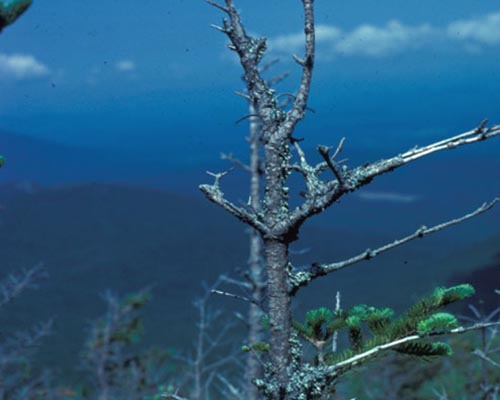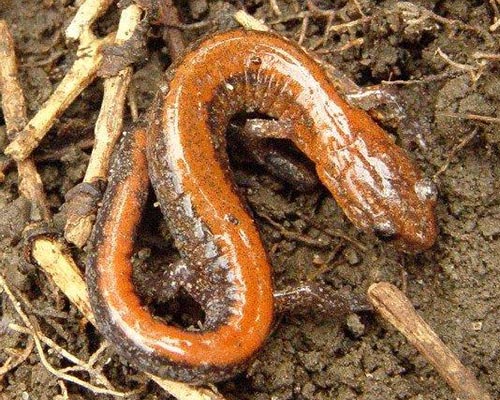The beauty of the Adirondacks is now threatened by climate change (see the Climate Change station). However, this is not the first threat the Adirondacks have faced. Beginning in the 1970s and 80s, acid precipitation has impacted the Adirondacks and many other northern forests worldwide.
Acid precipitation is rain, fog, snow and other forms of precipitation that is unusually acidic. Acidification can also occur by dry deposition. Acidification is caused by emissions of sulfur dioxide and nitrogen oxide from the burning of fossil fuels and other industrial activities, as well as from volcanic activity. These oxides react in the atmosphere with water to form strong acids such as sulfuric acid and nitric acid that can cause damage to organisms and ecosystems.
Acid rain due to industrial activity has been observed since the dawn of the Industrial Revolution, but it was only noticed as a widespread and important problem in the 1970s. By the early 1980s, 50 percent of canopy red spruce in the High Peaks area of the Adirondacks were dead or damaged. Other trees such as sugar maple, balsam fir and American beech were also affected, but red spruce (Picea rubens; see Plant Evolution III: Gymnosperms) was particularly vulnerable.
Trees were not the only organisms hurt. Red-backed salamanders (Plethodon cinereus) are small amphibians that live in moist deciduous forests under rocks and logs or in small burrows in the leaf litter. They are very common; in fact, it has been estimated that the Adirondacks may contain some 10 billion of them. They are thus extremely important ecologically. They eat vast numbers of insects and other invertebrates and provide vast quantities of food for their predators. Like many amphibians, red-backed salamanders do not have lungs; instead, they breathe through their moist skin. This makes them highly sensitive to water-borne pollution such as acid rain. According to studies, increasing soil acidity due to acid rain along with defoliation dramatically reduced red-backed salamander survival.
Red spruce and red-backed salamanders are indicator species, species that are particularly sensitive and thus indicate the health of the ecosystem they are in (see the Aquatic Life and Climate Change stations). By 1984, a study found that hundreds of lakes in the Adirondacks had markedly acidified, leaving these aquatic ecosystems that were once full of fish, frogs, waterbirds, aquatic insects and other life effectively barren. Adirondack lakes were hit particularly hard because watersheds here have a low buffering capacity. Unlike many other regions of New York, they do not neutralize acidity well.
Faced with this clear threat to the environment, Congress amended the Clean Air Act in 1990 to include provisions to address acid rain. As a result, between 1995 and 2011, sulfur dioxide emissions fell by 64 percent, and nitrogen oxide emissions fell by 67 percent. These improvements allowed red spruce to rebound and the forests and red-backed salamanders to begin their recovery.
However, computer modeling of oxide emissions, acid rain and the chemistry of Adirondack lakes provides a worrying picture of the future. The emissions reductions thus far have clearly proved beneficial; unfortunately, the rebound may be temporary. Decades of acid rain have depleted Adirondack soils of acid-neutralizing minerals such as calcium. As a result, even present oxide emission levels may prove too much in the long run; models suggest that lakes will re-acidify over the coming decades unless emissions are cut further.
Climate change, another environmental scourge that has been slowly building since the beginning of the Industrial Revolution, is now upon us as well. Interestingly, the carbon dioxide that is the main cause of climate change is now also causing the acidification of the Earth’s oceans. Our action to address acid rain provides some hope that we can again find the will to act on climate change before it is too late. Possible solutions could include the use of carbon-free energy sources like wind and solar. Since the Clean Air Act, the Adirondacks have begun to recover; however, there is still much that needs to be done if we are going to preserve the beauty of this place.


